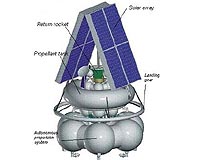 |
Sydney, Australia (SPX) Sep 13, 2010 Next year, Russia plans to launch a mission to Phobos, the largest moon of Mars. This spacecraft, called Phobos-Grunt, will be the first spacecraft to land on this moon, and also the first mission to return samples of Phobos to Earth. Phobos is an interesting object, and it's been studied a lot by orbiting spacecraft. The moon is in a fairly low orbit around Mars, which makes it easy to see from spacecraft placed in orbit around Mars. Earlier this year, the Mars Express orbiter got close enough to feel its gravitational tug, allowing us to explore the mass and density of this world without even landing. This upcoming mission to Phobos is the culmination of decades of close study of this strange, irregular moon, which could be a captured asteroid or an aggregation of rock that formed in Martian orbit. But Phobos has a twin. It's the small moon of Deimos, which lurks in a much higher orbit. Deimos has also been photographed regularly, but it's still relatively unknown. Let's size up the two moons for comparison. Phobos is roughly 28 kilometres long and 23 kilometres wide, extremely small for a planetary moon. Deimos comes in at 16 by 12 kilometres. The size and shape of both moons are similar, which could suggest a common origin. But this is not necessarily the case. Deimos is harder to explore because of its small size and its distant orbit, which places it a long way from most spacecraft that lurk around Mars. A Viking orbiter made a close approach in the 1970s, but the current orbiters around Mars can only observe from a fairly discreet distance. In the late 1980s, the soon-to-disappear Soviet Union launched two spacecraft towards Mars. Phobos 1 and 2 were nominally targeted to enter orbit around Mars, and then make a very close approach to the moon of Phobos. It was expected that Phobos 1 would fly close enough to the moon to blast its surface with laser beams, and scan the chemistry of the vapour it formed. Two small landers would also be dropped onto the surface. If Phobos 1 succeeded in its mission, there was talk of sending its sister, Phobos 2, to repeat the same type of mission with Deimos. Sadly, one spacecraft failed halfway to Mars. Its twin reached Martian orbit, but failed just before its close encounter with Phobos. Our best opportunity for a detailed look at Deimos was lost. Post-Soviet Russia is trying again to reach Mars, after an unsuccessful attempt to launch a Mars mission in 1996. Hopefully, the time and effort put into preparing this new mission for flight will pay off. If the Phobos Grunt mission succeeds, it will provide us with a reminder that we shouldn't ignore the other moon of Mars. There may not be enough initial interest in a special mission to land on Deimos, butan orbiter could be sent on a close approach in the future. Close photography and inspections of Deimos could provide us with valuable data, and it would be easier to make sense of that data with a detailed knowledge of Phobos. Are the moons similar or different? It would not take much inspection of Deimos to begin answering that question. We already know that the surface of Deimos seems smoother than Phobos, but we don't really know why. A future orbiter could fire a penetrator or a hard lander onto the surface of Deimos during a close flyby. This would give us "ground truth" data to compare to the extensive data set that is soon expected from Phobos. Eventually, if Deimos proves to be a very different beast to Phobos, a dedicated mission could be warranted. This could be a copy of the Phobos-Grunt mission, or a lander that will study the regolith in- situ. At the very least, a spacecraft making a mere flyby of Mars en route to another destination in the solar system could be targeted to fly close to Deimos. There's a lot of talk in some circles about sending astronauts to visit near-Earth asteroids in the future. Careful study of the moons of Mars could give us useful data for helping astronauts on their own journeys to small bodies in the solar system. Dr Morris Jones is an Australian writer and analyst. Email morrisjonesNOSPAMhotmail.com. Replace NOSPAM with @ to send email.
Share This Article With Planet Earth
Related Links - Mars News and Information at MarsDaily.com Lunar Dreams and more
 Russia to test Mars lander for 2011 flight
Russia to test Mars lander for 2011 flightMoscow (UPI) Sep 11, 2010 Russian scientists say they're preparing to test an unmanned lander for a 2011 mission to Phobos, one of the moons of Mars. The Phobos-Grunt spacecraft will land on the surface of Phobos, take soil samples and return them to Earth, RIA Novosti reported Friday. "The aim of the test is to narrow down the lander's projected impact location on the surface of the Earth," a statement b ... read more |
|
| The content herein, unless otherwise known to be public domain, are Copyright 1995-2010 - SpaceDaily. AFP and UPI Wire Stories are copyright Agence France-Presse and United Press International. ESA Portal Reports are copyright European Space Agency. All NASA sourced material is public domain. Additional copyrights may apply in whole or part to other bona fide parties. Advertising does not imply endorsement,agreement or approval of any opinions, statements or information provided by SpaceDaily on any Web page published or hosted by SpaceDaily. Privacy Statement |